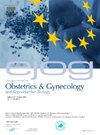Evaluation of serum-based inflammatory and haematological markers in patients with endometriosis: A case–control study
IF 1.9
4区 医学
Q2 OBSTETRICS & GYNECOLOGY
European journal of obstetrics, gynecology, and reproductive biology
Pub Date : 2025-10-02
DOI:10.1016/j.ejogrb.2025.114751
引用次数: 0
Abstract
Objective
To assess the diagnostic value of serum-based inflammatory and haematological markers in women with endometriosis, and determine their relationship with disease severity, including lesion characteristics.
Materials and methods
This prospective study included 103 patients with endometriosis (aged 18–45 years) and 103 healthy controls. Serum C-reactive protein (CRP), albumin and complete blood counts were obtained pre-operatively, and inflammatory markers [neutrophil-to-lymphocyte ratio (NLR), platelet-to-lymphocyte ratio, neutrophil-to-platelet ratio (NPAR), CRP-to-albumin ratio (CAR), systemic inflammation index (SII), systemic inflammatory response index (SIRI) and pro-inflammatory index (PIV)] were calculated. Surgical evaluation (laparoscopy/laparotomy) provided histopathological confirmation of endometriosis. The 1996 revised American Society for Reproductive Medicine (rASRM) classification was used for staging. Statistical analyses used t-tests, Mann–Whitney U-tests, Chi-squared tests, Spearman’s correlation, and linear regression modelling. p < 0.05 was considered to indicate significance.
Results
Compared with controls, patients with endometriosis had lower white blood cell (7.28 vs 8.43 × 103/mm3; p < 0.001), neutrophil (4.17 vs 5.09 × 103/mm3; p < 0.001) and CRP (2.45 vs 3.34 mg/l; p = 0.008) levels, but higher haemoglobin (12.8 vs 11.9 g/dl; p = 0.001) and haematocrit (40.5 % vs 38.1 %; p < 0.001) levels. NPAR (1.38 vs 1.48; p < 0.001), SII (539 vs 737; p < 0.001), SIRI (1004 vs 1337; p < 0.001), PIV (302 vs 422; p < 0.001), CAR (0.061 vs 0.079; p = 0.008) and NLR (1.89 vs 2.44; p < 0.001) were also significantly lower in patients with endometriosis. Postoperatively, NLR, SIRI, PIV and NPAR increased (p < 0.05). Receiver operating characteristic curve analysis indicated moderate diagnostic performance for neutrophil percentage, NLR, SII, SIRI and PIV. On multi-variate analysis, bilaterality (p < 0.001) and area of endometriomas (p = 0.020) correlated with rASRM score.
Conclusion
Serum inflammatory markers reflect systemic immune changes in endometriosis. Although they offer diagnostic insights, lesion bilaterality and size remain stronger predictors of disease severity. Larger, multi-centre studies are needed to refine cut-off values and optimize clinical application of these markers.
子宫内膜异位症患者血清炎症和血液学标志物的评估:一项病例对照研究
目的评价血清炎症和血液学指标对子宫内膜异位症的诊断价值,并确定其与疾病严重程度(包括病变特征)的关系。材料与方法本前瞻性研究纳入103例子宫内膜异位症患者(18-45岁)和103例健康对照。术前检测血清c反应蛋白(CRP)、白蛋白和全血计数,并计算炎症标志物[中性粒细胞与淋巴细胞比值(NLR)、血小板与淋巴细胞比值、中性粒细胞与血小板比值(NPAR)、CRP与白蛋白比值(CAR)、全身炎症指数(SII)、全身炎症反应指数(SIRI)和促炎指数(PIV)]。手术评估(腹腔镜/开腹)提供子宫内膜异位症的组织病理学证实。1996年修订的美国生殖医学学会(rASRM)分类被用于分期。统计分析使用t检验、Mann-Whitney u检验、卡方检验、Spearman相关和线性回归模型。P <; 0.05认为有显著性。结果与对照组相比,子宫内膜异位症患者白细胞(7.28 vs 8.43 × 103/mm3; p < 0.001)、中性粒细胞(4.17 vs 5.09 × 103/mm3; p < 0.001)和CRP (2.45 vs 3.34 mg/l; p = 0.008)水平较低,但血红蛋白(12.8 vs 11.9 g/dl; p = 0.001)和红细胞压差(40.5% vs 38.1%; p < 0.001)水平较高。子宫内膜异位症患者的NPAR (1.38 vs 1.48; p < 0.001)、SII (539 vs 737; p < 0.001)、SIRI (1004 vs 1337; p < 0.001)、PIV (302 vs 422; p < 0.001)、CAR (0.061 vs 0.079; p = 0.008)和NLR (1.89 vs 2.44; p < 0.001)也显著降低。术后NLR、SIRI、PIV、NPAR升高(p < 0.05)。患者工作特征曲线分析显示,中性粒细胞百分比、NLR、SII、SIRI和PIV的诊断效果中等。在多因素分析中,双侧性(p < 0.001)和子宫内膜瘤面积(p = 0.020)与rASRM评分相关。结论血清炎症指标反映了子宫内膜异位症的全身免疫变化。虽然它们提供了诊断见解,但病变的双侧性和大小仍然是疾病严重程度的更强预测因子。需要更大的、多中心的研究来细化临界值并优化这些标志物的临床应用。
本文章由计算机程序翻译,如有差异,请以英文原文为准。
求助全文
约1分钟内获得全文
求助全文
来源期刊
CiteScore
4.60
自引率
3.80%
发文量
898
审稿时长
8.3 weeks
期刊介绍:
The European Journal of Obstetrics & Gynecology and Reproductive Biology is the leading general clinical journal covering the continent. It publishes peer reviewed original research articles, as well as a wide range of news, book reviews, biographical, historical and educational articles and a lively correspondence section. Fields covered include obstetrics, prenatal diagnosis, maternal-fetal medicine, perinatology, general gynecology, gynecologic oncology, uro-gynecology, reproductive medicine, infertility, reproductive endocrinology, sexual medicine and reproductive ethics. The European Journal of Obstetrics & Gynecology and Reproductive Biology provides a forum for scientific and clinical professional communication in obstetrics and gynecology throughout Europe and the world.

 求助内容:
求助内容: 应助结果提醒方式:
应助结果提醒方式:


